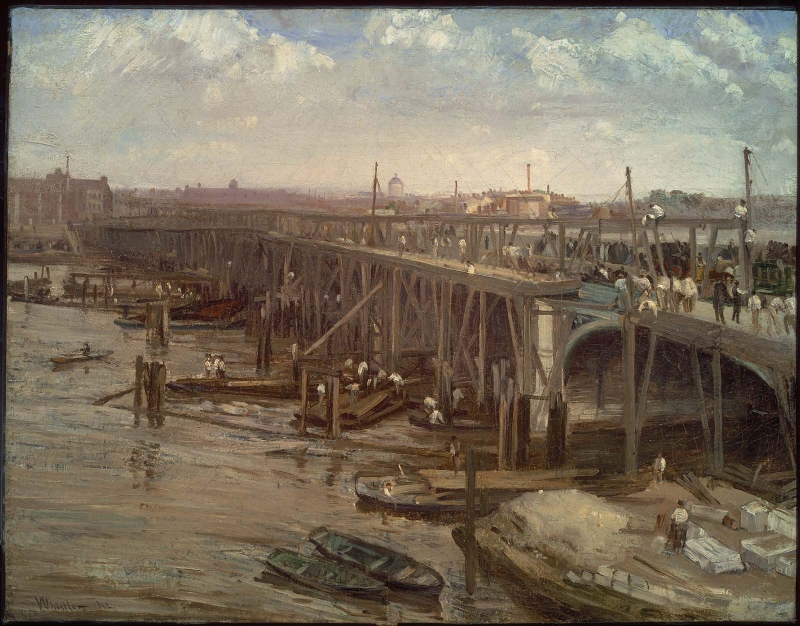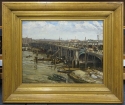Home > Catalogue > Browse > The Last of Old Westminster << >>
Composition
An X-ray has revealed the portrait of a seated woman, probably Joanna Hiffernan (b. ca 1843-d.1886), at right angles to the view of the bridge. The X-ray is discussed in a blog by Margaret MacDonald and Nadine Loach as follows:
'Whistler’s oil paintings of the Thames, combining closely observed realistic views, expressive brushwork and atmospheric colour, reward close examination. However, they can also conceal surprises, the ghostly records of earlier work. X-rays of two paintings by Whistler have resulted in a remarkable discovery. The paintings are Brown and Silver: Old Battersea Bridge (Addison Gallery of American Art) and The Last of Old Westminster (Boston Museum of Fine Arts).
It has long been known, from an X-ray, that there is a self-portrait of the artist, painted at right angles to the Thames riverscape, under Brown and Silver: Old Battersea Bridge.
It shows Whistler at work, painting with brush in hand, but was left unfinished and partly rubbed down. Nevertheless it is a vivid portrayal of the young artist, and was probably painted either in Paris or – more likely – in London ...
The Last of Old Westminster was also painted over a portrait, that of a seated woman, possibly a woman reading, which was also painted at right angles to the bridge, and partly rubbed down. ...
Although it is difficult to be certain, the woman, as seen in the X-ray, looks like Whistler’s Irish model Joanna Hiffernan. ...
The two portraits could be considered a pair: they are close in size, Brown and Silver: Old Battersea Bridge being 63.5 x 76.2 cm and The Last of Old Westminster, slightly different in proportion, [at 60.96 x 78.1 cm]. It is possible that they recorded a significant stage in the relationship between artist and model, as partners in the creation of works of art.
However, either these intimate portraits were sacrificed in order to make way for more saleable paintings of the river Thames, or Whistler simply felt that the portraits were not working out. Despite his close relationship with Jo, … or perhaps because of it, Whistler may have felt that he could not complete, hang or exhibit two such personal images. And so they were sacrificed for two immensely saleable, exhibitable – and very beautiful – paintings of Thames bridges.' 1
Technique
Underneath the painting of the bridge is the portrait of a woman, seated in profile to left, and some of the brushstrokes from this are still visible. Over this, the surface is carefully worked with paint in the background, vigorous long strokes of paint on the water, energetic brushwork in the sky, and much more thickly applied dabs and strokes of paint over the figures, the timber, and the bridge.
In 1903 Arthur Severn was quoted in the Morning Post, describing Whistler's working methods. The window from which Whistler painted, he said, looked 'across the river and down on the rickety steamboat pier which spanned the mud bank', and, he added:
'It was a bow window, with views up and down the river, and the pier and bridge were close by under it. I had an idea that he [Whistler] would do the picture very quickly, but he took weeks over it ... most of the stone work had been removed and many wooden piles were being driven into the deep mud. To my uneducated eye these piles looked all about the same grey, and the shirts of the little figures working looked to me all the same white, but Whistler spent much time getting various tones out of the heaps of colour on his large palette. After securing the exact shade of grey or white which he wanted he did his pile or shirt with a few small dexterous dabs, screwing up his eyes and expressing satisfaction if successful.' 2
Arthur Severn also told Whistler's biographers, the Pennells:
'It was the piles with their rich colour and delightful confusion that took his fancy, not the bridge, which hardly showed. He would look steadily at a pile for some time, then mix up the colour, then holding his brush quite at the end, with no mahlstick, make a downward stroke and the pile was done. I remember once his looking very carefully at a hansom cab that had pulled up for some purpose on the bridge, and in a few strokes he got the look of it perfectly. He was a long time over the picture, sometimes coming only once a week, and we got rather tired of it.' 3
A visual examination of this painting confirms that it was painted on site over several weeks. The elements in the scene that changed from day to day – the position of the small boats and barges on the river, and the workmen on the bridge and bank of the river – have in many cases been painted over, and completely different figures and boats were painted quite thickly on top. Some of the wooden struts and piers were also moved; for instance, the prominent pole in the foreground, to right of centre, was originally further right, and is still visible to right of the current pole. No attempt seems to have been made to rub or scrape down such items before substituting others. These alterations were not small adjustments of the composition: they must have completely changed the appearance of the picture from day to day.
In 1892 Whistler's wife, Beatrice Philip (Mrs E. W. Godwin, Mrs J. McN. Whistler) (1857-1896), wrote, on Whistler's behalf, to the art dealer Edward Guthrie Kennedy (1849-1932): 'The tone you admire under the bridge is solid painting'; it was not, as Kennedy had thought, 'scumbled.' 4
Conservation History
On 12 June 1892, Whistler wrote to the picture restorer Stephen Richards (1844-1900):
'Now I understand that you will have brought to you, almost directly, four more pictures by me; I have said that you are the only man fit to touch my work, therefore, you must prove again how right I am ... You will clean and take off the varnish with the utmost care and tenderness - Two of the pictures have not been cleaned since they were first painted. They ought all to come out in the most brilliant condition.' 5
The two that had not been cleaned were The Last of Old Westminster and Variations in Flesh Colour and Green: The Balcony [YMSM 056].
However, despite Richards' care, by 1905 parts of the painting were, according to Bernhard Sickert (1862-1932), 'badly cracked, probably from repainting'. 6 Julius Meier-Graefe (1867-1935) also noticed 'numerous cracks in the thick impasto'. 7 There are cracks and areas of craquelure throughout.
Frame
- 1862: make and style unknown, whereabouts unknown.
- ca 1892: Grau-style, possibly American-made. [FD] 93.98 x 111.13 cm (37 x 43 ¾") [MW] 16.51 cm (6 ½").
Whistler described the earlier frame as 'hideous' and recommended a frame maker, Frederick Henry Grau (1859-1892):
'You ought to have my new frames made at once for The Westminster Bridge and the Thames picture - both of which must be in hideous old things - and they should have glass upon them ...
My frame maker is Mr Grau. 570. Fulham Road - He must not have the pictures at his place - but must go to Richards and take the measures immediately - and be pushed without giving him any peace - as he is as procrastinating as he is capable -
He is the only one who has the true pattern of my frame - Tell him that the gold must be the pale yellow soft gold like the gilding of my Mother's frame.' 8
According to Dr Parkerson Day, the construction of the current frame is similar to Grau-made frames, but it lacks his signature. 9 Kennedy did not follow Whistler’s instructions, but ordered a new frame in New York. In a letter to Beatrice Whistler, he wrote:
'I wrote to you from London that the reason I did not order three frames was, that we make our own frames, and thus save duty on the frames, besides making a better article, or rather one which won't split or crack in our climate.
... I told Richards not to send the old frames but just the canvasses, thus saving expenses to both of us. This has evidently been neglected.' 10
Thus the old frame may have got as far as New York before being abandoned, and the current frame is probably American made, following the Grau style.
Notes:
1: MacDonald, Margaret and Nadine Loach, 'Whistler's Ghosts', James McNeill Whistler and his Art, A blog about James McNeill Whistler, March 2014, website at https://jmcnwhistler.wordpress.com. See also MacDonald, Margaret F., 'Joanna Hiffernan and James Whistler: an Artistic Partnership' in Margaret F. MacDonald (ed.), The Woman in White: Joanna Hiffernan and James McNeill Whistler, New Haven and Washington, 2020, pp. 15-31.
2: 'Art and Artists', Morning Post, London, 16 November 1903, pp. 4-5.
3: Pennell 1908 [more], vol. 1, pp. 100-01.
4: [27 June 1892], GUW #09688.
6: B. Sickert 1908 A [more], pp. 10, 102.
7: Meier-Graefe, Julius, Modern Art, trans. Frank Simmonds and G.W. Chrystal, 2 vols, London and Paris, 1908, vol. 2, p. 206.
8: Whistler to E. G. Kennedy, [13 June 1892], GUW #09685, referring to The Last of Old Westminster, Battersea Reach [YMSM 045] and Arrangement in Grey and Black: Portrait of the Painter's Mother [YMSM 101].
9: Dr S. L. Parkerson Day, Report on frames, 2017; see also Parkerson 2007 [more].
Last updated: 4th June 2021 by Margaret










